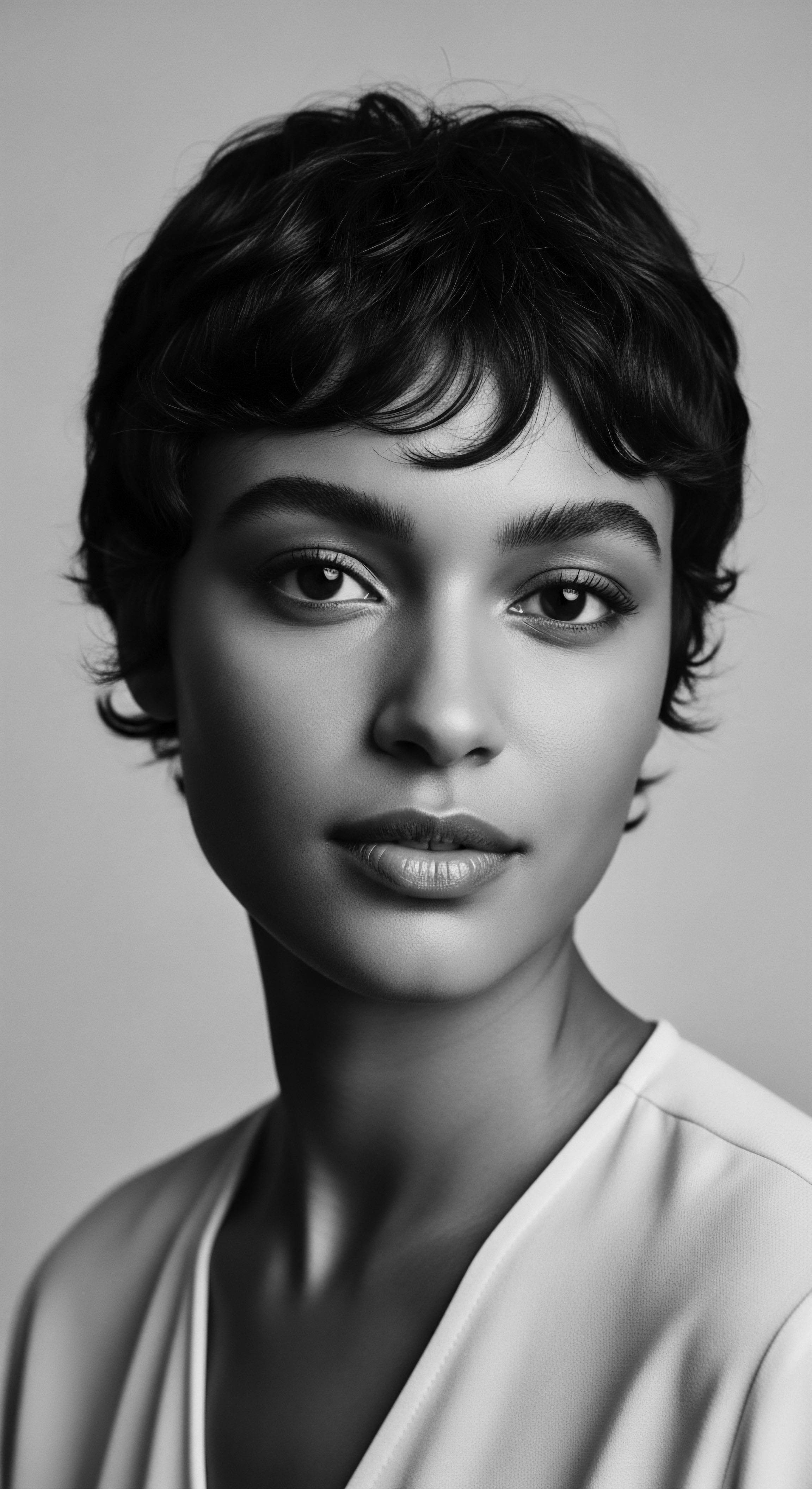
Fundamentals
The sun, a giver of life and warmth, also possesses an invisible side, a spectrum of light that, while unseen, carries potent energy. Within this unseen realm lies Ultraviolet (UV) Radiation, a force that can, over time, impart a specific kind of wear upon our hair strands. This phenomenon, known as UV Hair Damage, represents the structural and aesthetic changes that occur when hair is subjected to prolonged or intense exposure to the sun’s radiant energy.
It is a process of degradation, an alteration of the hair’s very composition, that diminishes its inherent vitality and appearance. The fundamental meaning of UV hair damage, therefore, lies in this environmental assault, where the hair, a fibrous protein structure, meets the relentless energy of solar rays.
At its simplest, UV Hair Damage is the photodegradation of hair. The term ‘photodegradation’ itself offers a clear explanation ❉ ‘photo’ refers to light, and ‘degradation’ signifies a breakdown or deterioration. Thus, it is a breakdown caused by light. The sun emits two primary types of UV radiation that concern hair ❉ UVA and UVB.
Both play distinct roles in the damage observed. UVB radiation, though it penetrates less deeply, is a significant contributor to the loss of hair proteins, while UVA radiation is largely responsible for alterations in hair color. These rays do not merely sit upon the hair’s surface; they are absorbed by the hair fibers, initiating a cascade of reactions that compromise the strand from its outermost protective layer to its innermost core.
Consider the hair shaft as a meticulously crafted natural fiber, composed primarily of a protein called Keratin, interwoven with lipids and natural pigments. The outermost shield, the Cuticle, comprises overlapping cells, much like the scales of a fish or shingles on a roof, designed to guard the delicate interior. The inner layer, the Cortex, gives hair its strength, elasticity, and color, owing to the presence of melanin. When UV rays strike, they initiate a process akin to oxidation, where reactive molecules, often called Free Radicals or Reactive Oxygen Species (ROS), are generated.
These highly reactive entities then react with the hair’s proteins and lipids, causing them to break down. This internal assault manifests externally as a range of visible changes, signaling a departure from the hair’s optimal state.
UV Hair Damage is the sun’s silent sculptor, reshaping hair’s very architecture through an unseen, energetic dialogue.
The degradation of hair proteins, especially keratin, is a primary consequence of UV exposure. The hair’s inherent amino acids, the building blocks of these proteins, absorb UV radiation, leading to their photochemical degradation. This process can lead to a decrease in hair strength, a roughening of the surface texture, and an increase in brittleness. The hair’s natural luster, a hallmark of its vitality, often diminishes, replaced by a duller, more lifeless appearance.
Beyond structural changes, UV radiation directly impacts the hair’s natural pigment, Melanin. Melanin, the very substance that bestows color upon our strands, also serves as a natural photoprotectant, absorbing and filtering harmful UV rays. However, in the process of absorbing this radiation, melanin itself degrades, leading to visible lightening or color changes. For those with darker hair, the melanin content offers a degree of inherent protection, yet it is not impervious to the sun’s relentless influence.
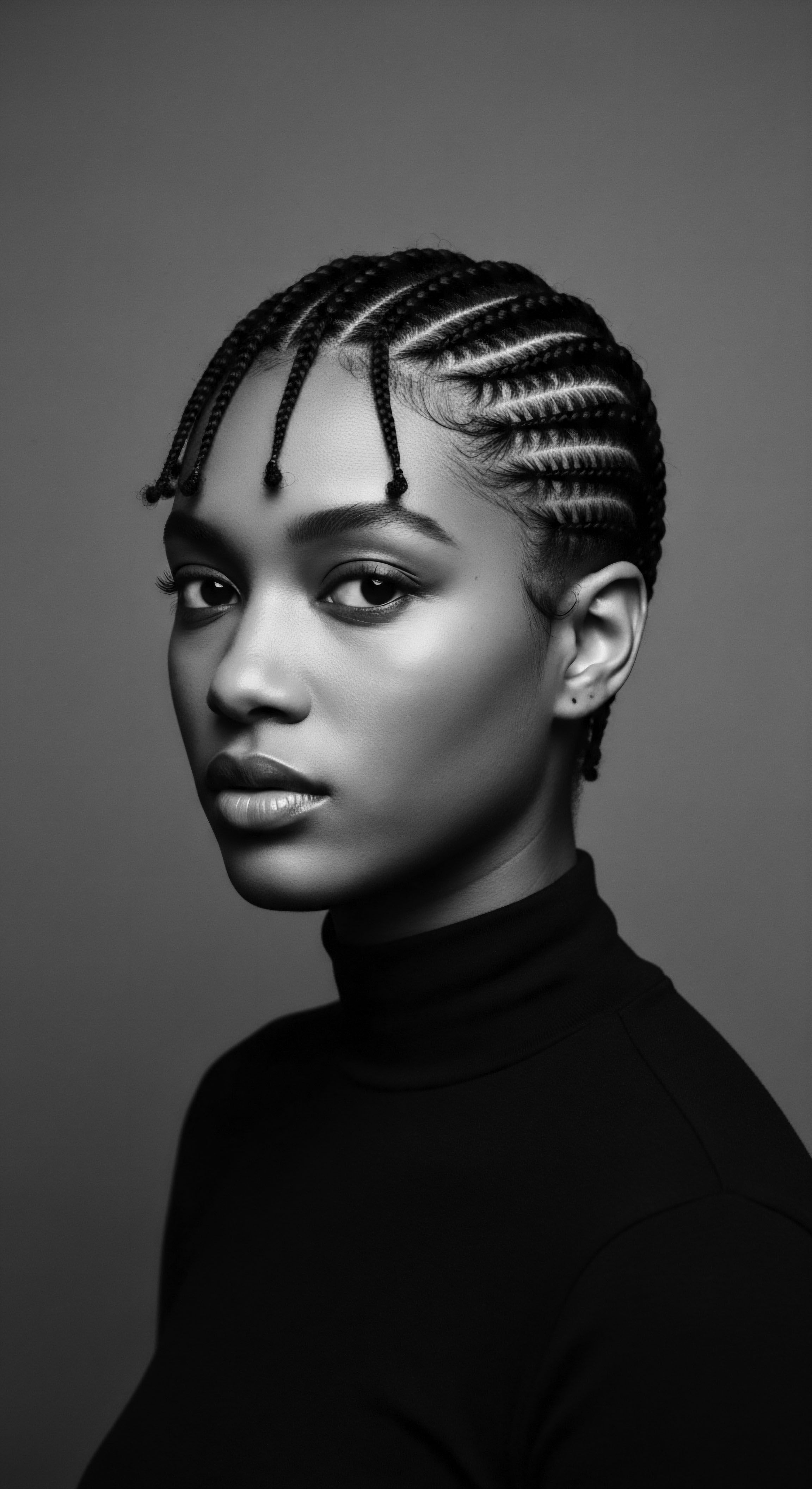
The Sun’s Touch on Hair’s Foundation
The sun’s radiant energy, though vital for life, can exert a corrosive influence on the hair’s delicate structures. This influence, when protracted, begins to dismantle the very foundations of hair health. The initial impact is often felt at the hair’s outermost boundary, the cuticle. This protective layer, akin to the bark of a tree, bears the brunt of the sun’s direct assault.
Lipids and proteins within these cuticle cells degrade, causing them to lift and become more fragile. Such an alteration renders the hair more susceptible to external stressors, including moisture loss and further environmental compromise.
The penetration of UV rays into the hair shaft extends beyond the cuticle, reaching the cortex, where the bulk of the hair’s structural integrity resides. Here, chemical bonds that cross-link hair’s proteins are broken, systematically weakening the hair’s strength. This internal disruption leads to observable consequences, including increased porosity and a propensity for breakage. The overall implication is a diminished capacity for the hair to retain moisture, leading to a sensation of dryness and a visibly coarser texture.
- Keratin Degradation ❉ The primary protein of hair, keratin, suffers structural damage from UV exposure, leading to weakened strands.
- Lipid Oxidation ❉ Essential lipids that coat the hair and provide moisture are oxidized, contributing to dryness and a loss of natural sheen.
- Melanin Photobleaching ❉ The natural pigments in hair, responsible for its color, degrade upon UV absorption, resulting in fading or unwanted tonal shifts.
Understanding these fundamental aspects of UV Hair Damage is the initial step in appreciating the complexities of hair care, particularly for textured hair, which carries its own unique heritage and biological characteristics that interact with these environmental pressures.
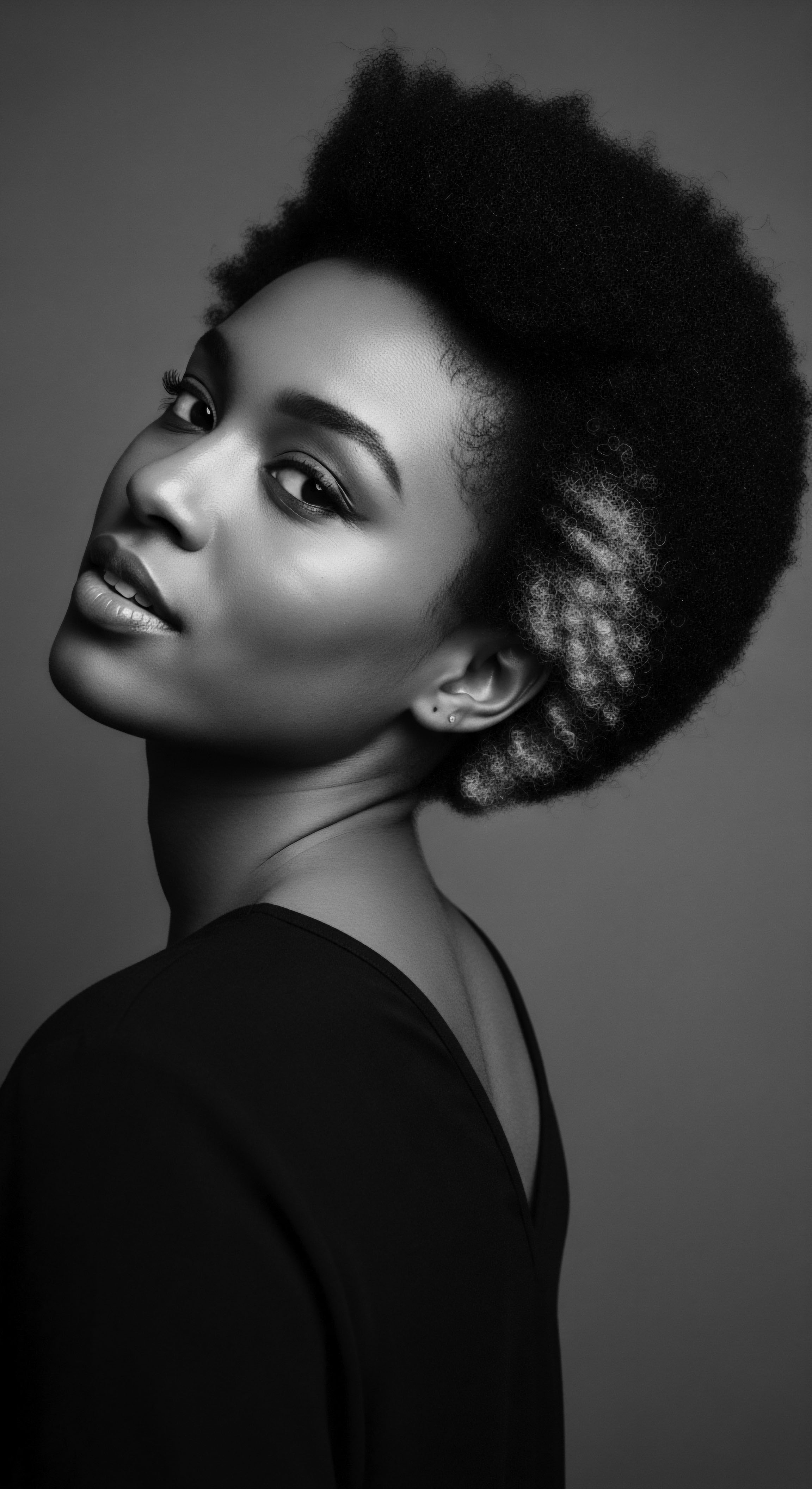
Intermediate
Moving beyond the foundational understanding, the intermediate meaning of UV Hair Damage reveals a more intricate interplay of molecular processes and their macroscopic manifestations, particularly as they pertain to the unique architecture of textured hair. The hair fiber, a complex biological composite, reacts to solar radiation not merely through surface changes but through a chain of reactions that reach deep within its core. This level of inquiry requires a closer look at the specific wavelengths involved and the cascade of oxidative events they trigger, which ultimately compromise the hair’s resilience and aesthetic integrity.
The spectrum of UV radiation, broadly categorized into UVA (320-400 nm) and UVB (280-320 nm), each presents a distinct challenge to hair health. UVB rays, while not penetrating as deeply as UVA, are particularly adept at causing protein loss and structural damage to the keratin within the hair shaft. This includes the breakage of Disulfide Bonds, the robust chemical linkages that provide much of hair’s strength and stability. When these bonds are compromised, the hair’s internal scaffolding weakens, leading to increased brittleness and a greater susceptibility to breakage.
UVA radiation, conversely, penetrates further into the cortex, primarily instigating color changes through the degradation of melanin. This dual assault means that UV Hair Damage is not a singular event but a complex, multi-layered process affecting both the physical strength and the visual vibrancy of the hair.
A key mechanism in this degradation is the generation of Reactive Oxygen Species (ROS), also known as free radicals. When UV radiation interacts with photosensitive amino acids within the hair, these highly reactive molecules are formed. These free radicals then propagate a destructive cycle, attacking hair proteins, particularly keratin, and lipids. This oxidative stress is akin to the rusting of metal, albeit on a microscopic biological scale, leading to a breakdown of the hair’s structural components.
The cuticle, being the outermost layer, bears the brunt of this oxidative onslaught, leading to its degradation and the lifting of its protective cells. This compromise of the cuticle then exposes the inner cortex to further environmental damage, creating a vicious cycle of deterioration.
The silent dance of light and hair unravels its deepest structures, revealing a narrative of resilience and vulnerability.
The significance of UV Hair Damage extends beyond mere cosmetic concern, delving into the very physical and chemical integrity of the hair fiber. For textured hair, often characterized by its unique curl patterns, porosity, and natural dryness, the implications are particularly pronounced. The inherent architecture of coils and kinks means that the cuticle layers may be more exposed at various points along the strand, potentially rendering textured hair more susceptible to environmental stressors, including UV radiation. Moreover, the natural oils produced by the scalp, which serve as a protective barrier, may not travel as easily down the length of highly coily or kinky strands, leaving the ends more vulnerable to dryness and damage, a condition exacerbated by UV exposure.
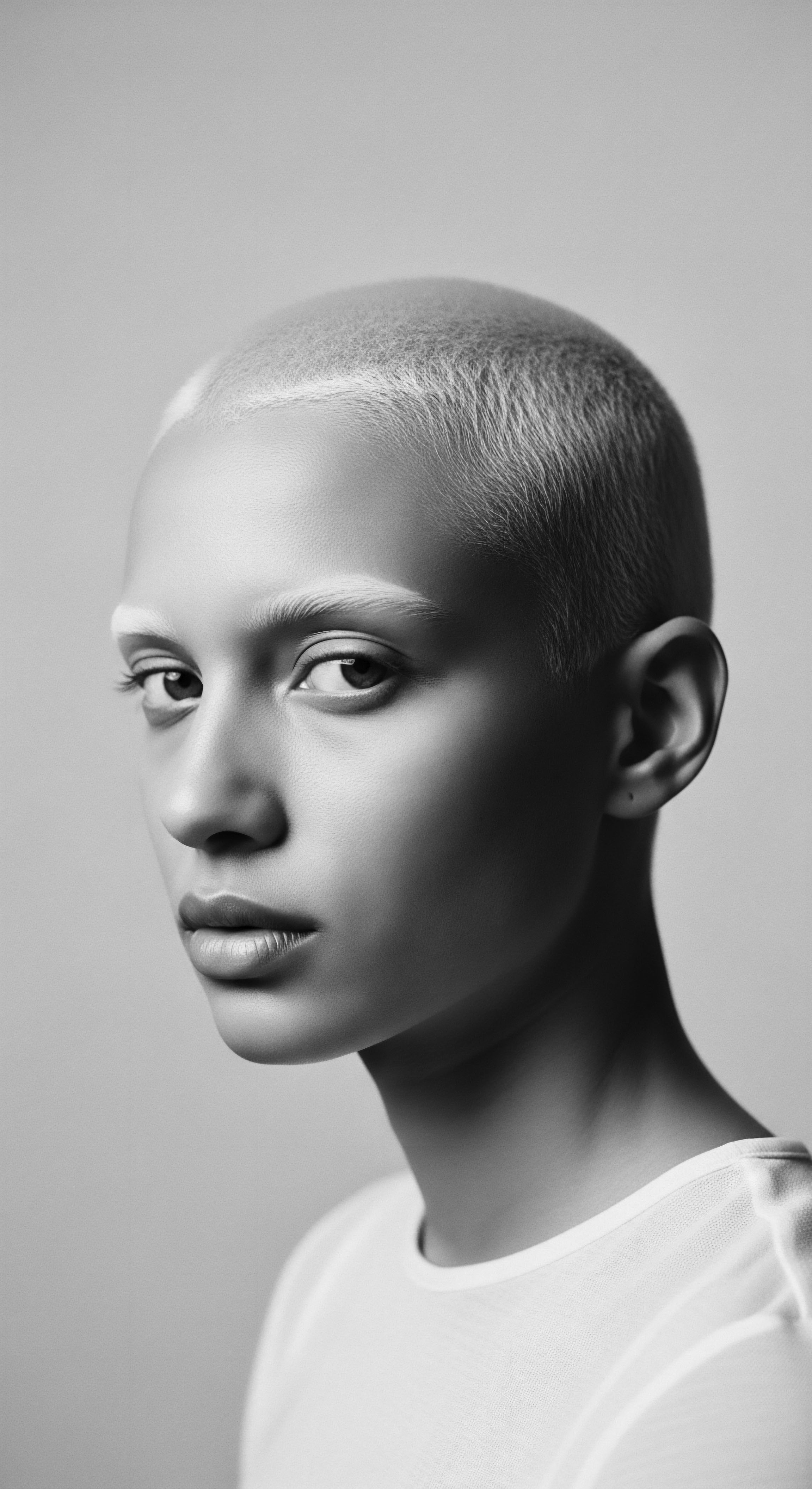
Historical Responses to Sun’s Influence
Throughout history, communities with textured hair, particularly those across Africa and its diaspora, developed profound traditions and practices that, while perhaps not explicitly labeled as “UV protection,” served as potent defenses against environmental stressors, including the sun. These practices represent an ancestral wisdom, a deep understanding of natural elements and their beneficial application to hair and scalp health. The heritage of textured hair care is rich with examples of intentional actions designed to preserve the hair’s integrity in challenging climates.
- Headwraps and Coverings ❉ Across numerous African cultures, headwraps, known by names such as ‘gele’ in Nigeria, ‘dukus’ in Ghana, and ‘doeks’ in South Africa, were not merely adornments or markers of social status, but served a practical purpose of protecting the hair and scalp from the intense sun. This tradition, carried across the Atlantic during the transatlantic slave trade, persisted as a means of both protection and cultural assertion, even when laws were enacted to enforce their wear as symbols of subservience. The strategic use of textiles provided a physical barrier against direct solar exposure, a simple yet highly effective method passed down through generations.
- Natural Oils and Butters ❉ The application of natural emollients was a widespread practice. Shea Butter, derived from the shea nut tree native to West Africa, has been used for centuries to moisturize and protect both skin and hair from sun, wind, heat, and saltwater. Its natural content of cinnamic acid offers a mild sunscreen effect, approximately SPF-6. Similarly, Argan Oil, from Morocco, was known in folk medicine for its hair and skin-protective properties, valued for its ability to nourish, strengthen, and repair hair. These oils and butters created a protective film on the hair shaft, helping to seal in moisture and provide a barrier against environmental elements, including UV radiation.
- Protective Styling ❉ Intricate braiding and coiling styles, common across various African communities, offered another layer of defense. Styles like cornrows, threading, and elaborate braids, often adorned with natural elements, not only communicated identity and status but also minimized the surface area of hair directly exposed to the sun. By gathering and securing the hair, these styles reduced the overall impact of solar radiation on individual strands, thereby preserving moisture and reducing breakage.
These ancestral practices represent a sophisticated understanding of hair’s needs within specific environmental contexts. They underscore a deep connection to the land and its resources, utilizing what was available to maintain hair health and vitality. The heritage of these practices provides a rich background against which to interpret modern scientific understandings of UV Hair Damage, recognizing that many contemporary recommendations echo the wisdom of those who came before us.
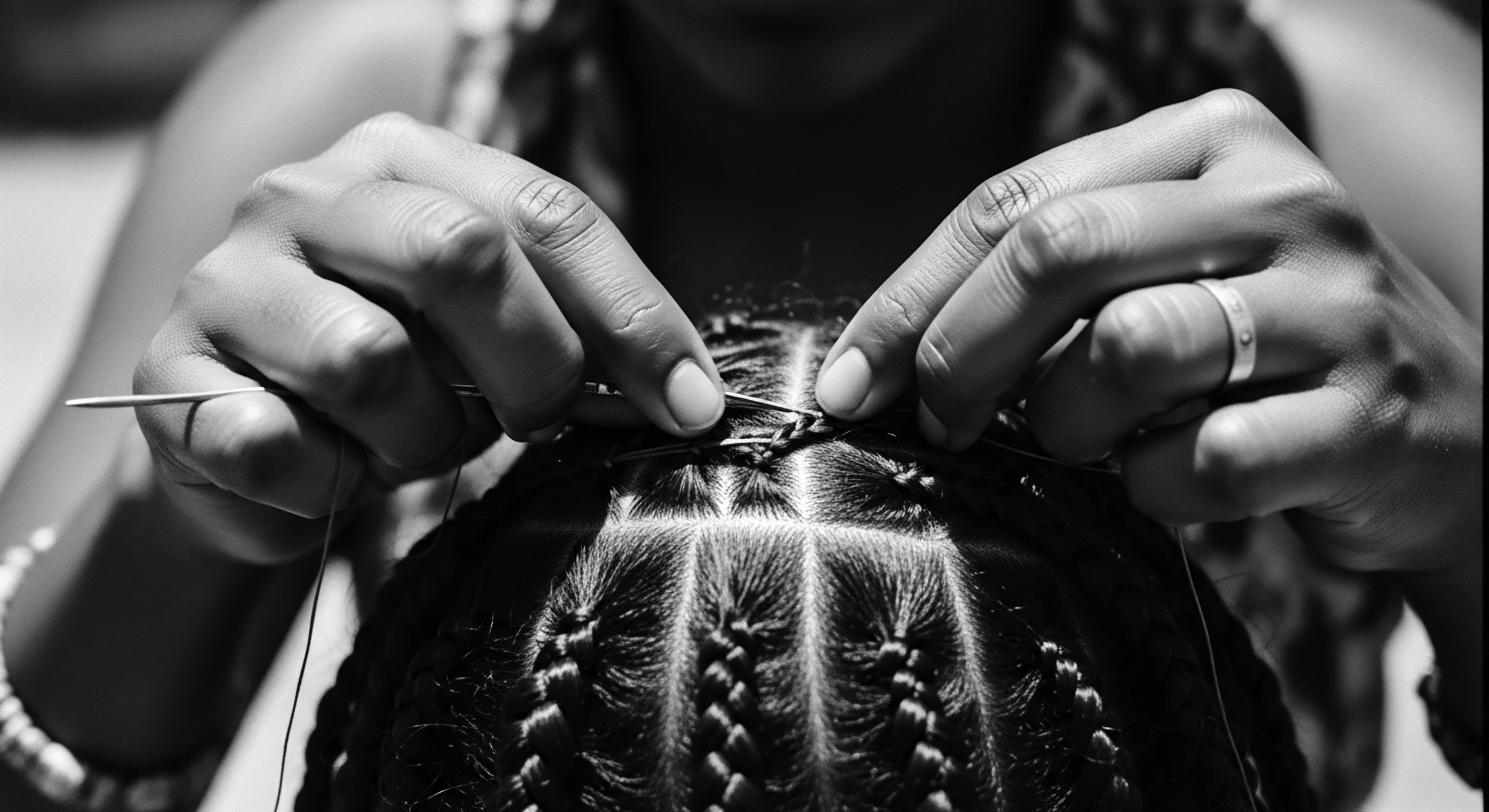
Academic
The academic definition of UV Hair Damage transcends a superficial understanding, delving into the precise biochemical and biophysical alterations that occur at the molecular level, particularly emphasizing their unique implications for textured hair. This scholarly perspective views UV Hair Damage as a complex photodegradative process, where specific wavelengths of solar radiation induce irreversible changes to the hair fiber’s protein matrix, lipid layers, and pigmentary components. The meaning of this phenomenon is grounded in the disruption of covalent bonds, the generation of reactive oxygen species, and the subsequent compromise of the hair’s structural integrity and aesthetic qualities. It represents a continuous assault on the hair’s fundamental composition, leading to a cumulative and progressive deterioration that is often more pronounced in certain hair types due to their inherent structural characteristics.
At its core, UV Hair Damage involves the absorption of photons by chromophores within the hair shaft, notably amino acids such as Cystine, Tryptophan, Tyrosine, and Methionine, as well as the melanin pigments. This absorption leads to photo-oxidation, a process where light energy catalyzes oxidative reactions. UVB radiation (280-320 nm) is particularly effective at inducing protein loss and the cleavage of disulfide bonds within the keratin structure, which are critical for hair’s mechanical strength. The breakage of these bonds, formed by cystine residues, results in the formation of sulfhydryl groups and other sulfur-containing species, weakening the hair’s tensile properties and increasing its susceptibility to fracture.
Conversely, UVA radiation (320-400 nm) penetrates more deeply and is primarily implicated in the photodegradation of melanin, leading to color changes, including lightening and unwanted brassy tones. This differential absorption and impact underscore the multifaceted nature of solar damage.
The generation of Free Radicals (reactive oxygen species) is a central mechanism in UV-induced hair degradation. Upon UV exposure, these highly reactive molecules are formed, initiating a chain reaction that damages lipids and proteins throughout the hair shaft. For instance, unsaturated fatty acids, particularly linoleic acid, present between the cuticle layers, can produce hydroxy radicals upon UV exposure, leading to the formation of cuticle holes and further damage.
This oxidative stress also extends to the hair’s surface lipids, compromising the protective 18-methyl eicosanoic acid (18-MEA) layer, which is crucial for maintaining hydrophobicity and cuticle integrity. The loss of this lipid layer exacerbates moisture depletion and increases friction between strands, contributing to a rougher texture and greater tangling.
UV Hair Damage is a biochemical symphony of molecular disruption, echoing across the strands a story of environmental impact and ancestral resilience.
The implications of UV Hair Damage for textured hair, particularly Black and mixed-race hair, are profoundly significant and rooted in both biological and historical contexts. While melanin offers a degree of natural photoprotection by absorbing UV radiation and scavenging free radicals, this protective capacity is not infinite; melanin itself degrades in the process. Furthermore, research suggests that darker hair, often characterized by higher eumelanin content, may experience greater protein loss in the cuticle area when exposed to UV radiation, due to the presence of more photosensitive amino acids like cystine. This finding, while seemingly counterintuitive, highlights the complex interaction between pigment and protein degradation under solar assault.
A critical lens through which to examine this is the historical context of hair care within diasporic communities. The unique coily and kinky structures of textured hair mean that the cuticle layers may be less uniformly sealed and more prone to lifting, exposing the cortex to environmental stressors. This inherent structural characteristic, combined with the historical lack of access to appropriate care products and the societal pressures to alter natural hair textures, has created a legacy of vulnerability.
During the transatlantic slave trade, the deliberate stripping of traditional hair care practices and tools, coupled with forced labor under harsh sun, directly contributed to severe hair degradation among enslaved Africans. The hair, once a symbol of identity and spiritual connection, became a site of profound physical and cultural trauma, often tucked away to conceal its condition.
The historical example of the Tignon Laws in 18th-century Louisiana offers a powerful illustration of this intersection of environmental challenge, cultural identity, and imposed vulnerability. Enacted in 1785 by Spanish colonial governor Esteban Rodriguez Miró, these laws mandated that free Black and mixed-race women wear head coverings (tignons) to distinguish them from white women and signify a lower social status. This legal imposition, while intended to strip agency and cultural expression, inadvertently reinforced an ancestral practice of head covering for sun protection, even as it simultaneously served as a tool of oppression. Enslaved people in the Americas often wore headwraps on plantations to protect themselves from the sun, sweat, and lice while working.
However, the forced nature of the tignon laws, despite their functional benefit of sun protection, became a symbol of societal control. Yet, these women, with profound resilience, transformed the tignon into a statement of defiance and beauty, adorning them with luxurious fabrics and elaborate styles, reclaiming a visual language of selfhood. This historical instance underscores how practices, even those with clear environmental protective benefits like shielding hair from UV, can become entangled in complex narratives of power, identity, and survival within the heritage of textured hair.
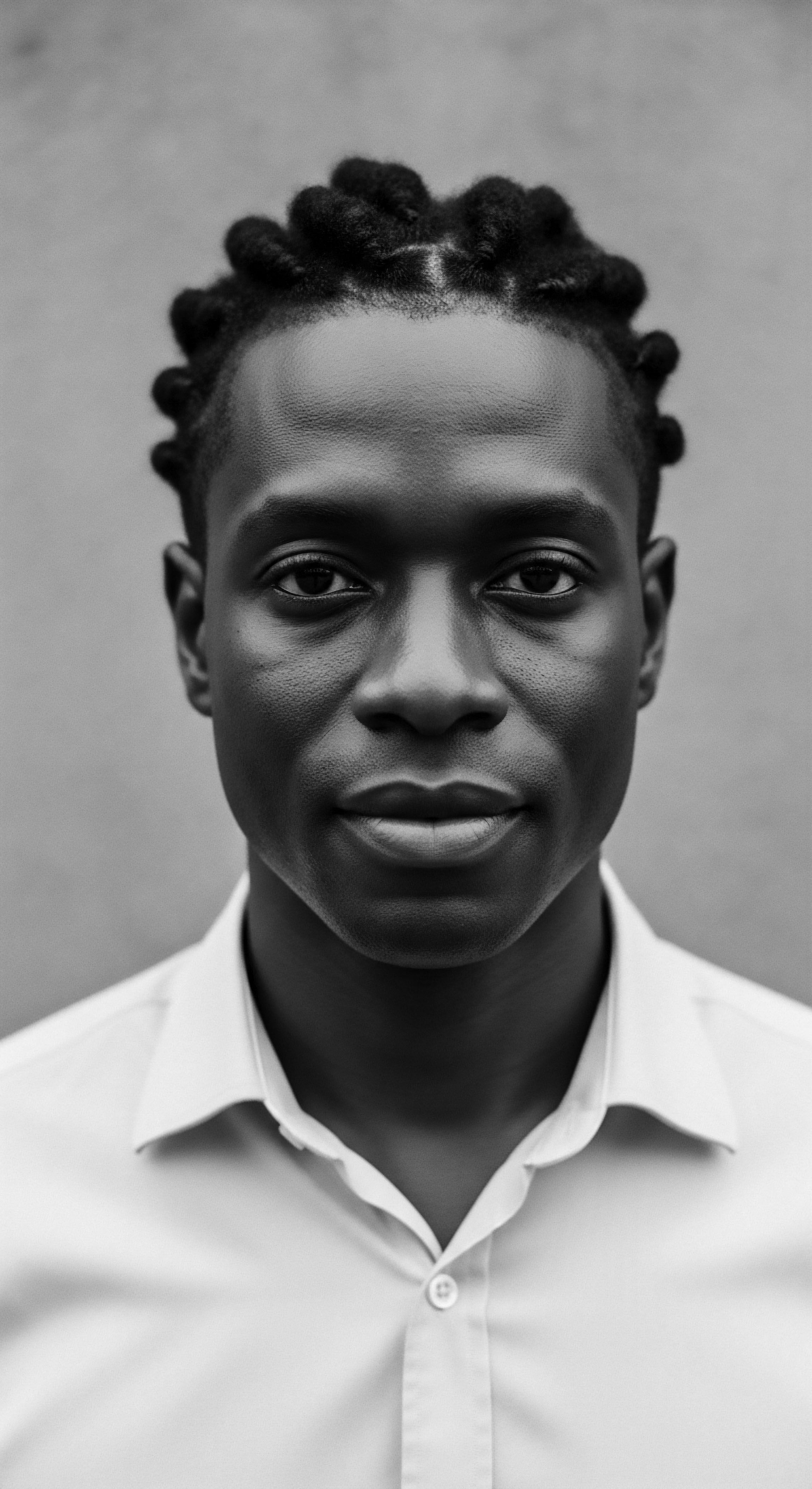
Deep Dive into Hair’s Microscopic Vulnerabilities
The microscopic world of the hair fiber reveals specific vulnerabilities to UV radiation that are exacerbated by the structural nuances of textured hair. The outermost layer, the cuticle, is the first line of defense, composed of overlapping cells. When UV rays impact these cells, they induce a process known as Protein Carbonylation, a form of oxidative damage that leads to changes in the protein structure. This alteration can cause the cuticle cells to lift, fray, and detach, exposing the underlying cortex.
The integrity of the cuticle is paramount for maintaining hair’s shine, smoothness, and overall health. Its compromise renders the hair rough to the touch, prone to tangling, and diminishes its aesthetic appeal.
The cortex, the hair’s primary structural component, is a dense matrix of keratin proteins. Within this matrix, the aforementioned disulfide bonds provide much of the hair’s strength and elasticity. UV radiation directly attacks these bonds, converting cystine to less stable forms, leading to a significant reduction in hair’s mechanical properties.
This weakening is particularly critical for textured hair, which, due to its helical and sometimes irregular growth patterns, may experience uneven stress distribution along the fiber, making it more susceptible to breakage once its internal bonds are compromised. The melanin granules, also residing in the cortex, absorb UV light to protect the protein, but this absorption causes them to degrade, leading to color changes and a reduction in their protective capacity.
The role of water content in hair’s susceptibility to UV damage is also a notable consideration. Hair exposed to UV radiation in a humid environment or while wet experiences amplified oxidative reactions. Water acts as a medium, facilitating the interaction of reactive chemicals and promoting the formation of free radicals.
This means that activities like swimming or spending time in humid climates under the sun can significantly increase the rate and severity of UV Hair Damage. For textured hair, which often has a higher natural porosity and may retain water differently, this factor takes on added importance, requiring diligent protective measures.
| Aspect of Protection Physical Barrier |
| Ancestral Practice/Material (Pre-19th Century) Headwraps (Gele, Dukus, Tignons) |
| Modern Scientific Link/Understanding Directly blocks UV radiation, preventing absorption by hair shaft. Reduces overall exposure. |
| Aspect of Protection Moisture Retention & Barrier |
| Ancestral Practice/Material (Pre-19th Century) Shea Butter (Vitellaria paradoxa), Argan Oil (Argania spinosa) |
| Modern Scientific Link/Understanding Rich in fatty acids and antioxidants; forms a protective film, reduces water loss, and offers mild natural SPF. |
| Aspect of Protection Antioxidant & Nutritional Support |
| Ancestral Practice/Material (Pre-19th Century) Amla Oil (Emblica officinalis), Sesame Oil (Sesamum indicum) |
| Modern Scientific Link/Understanding Provides Vitamin C and antioxidants that scavenge free radicals, counteracting oxidative stress from UV. |
| Aspect of Protection Protective Styling |
| Ancestral Practice/Material (Pre-19th Century) Braids, Cornrows, Coiling Styles |
| Modern Scientific Link/Understanding Minimizes exposed surface area of hair, reducing direct UV impact on individual strands and scalp. |
| Aspect of Protection The enduring wisdom of ancestral practices for safeguarding hair from environmental stressors, including solar radiation, finds resonance and scientific affirmation in contemporary understanding. |
The degradation of hair due to UV radiation is not merely a cosmetic inconvenience; it is a profound alteration of the hair’s biological structure. The cumulative effects of prolonged exposure can lead to irreversible changes, impacting the hair’s ability to retain moisture, maintain its color, and resist mechanical stress. For textured hair, where the inherent structural characteristics may present additional vulnerabilities, a deep understanding of these mechanisms, coupled with a reverence for ancestral protective practices, forms the bedrock of holistic and effective care. This academic exploration, therefore, is not an isolated scientific pursuit but an extension of a long-standing human endeavor to understand and protect the hair that has always been so deeply intertwined with identity and heritage.
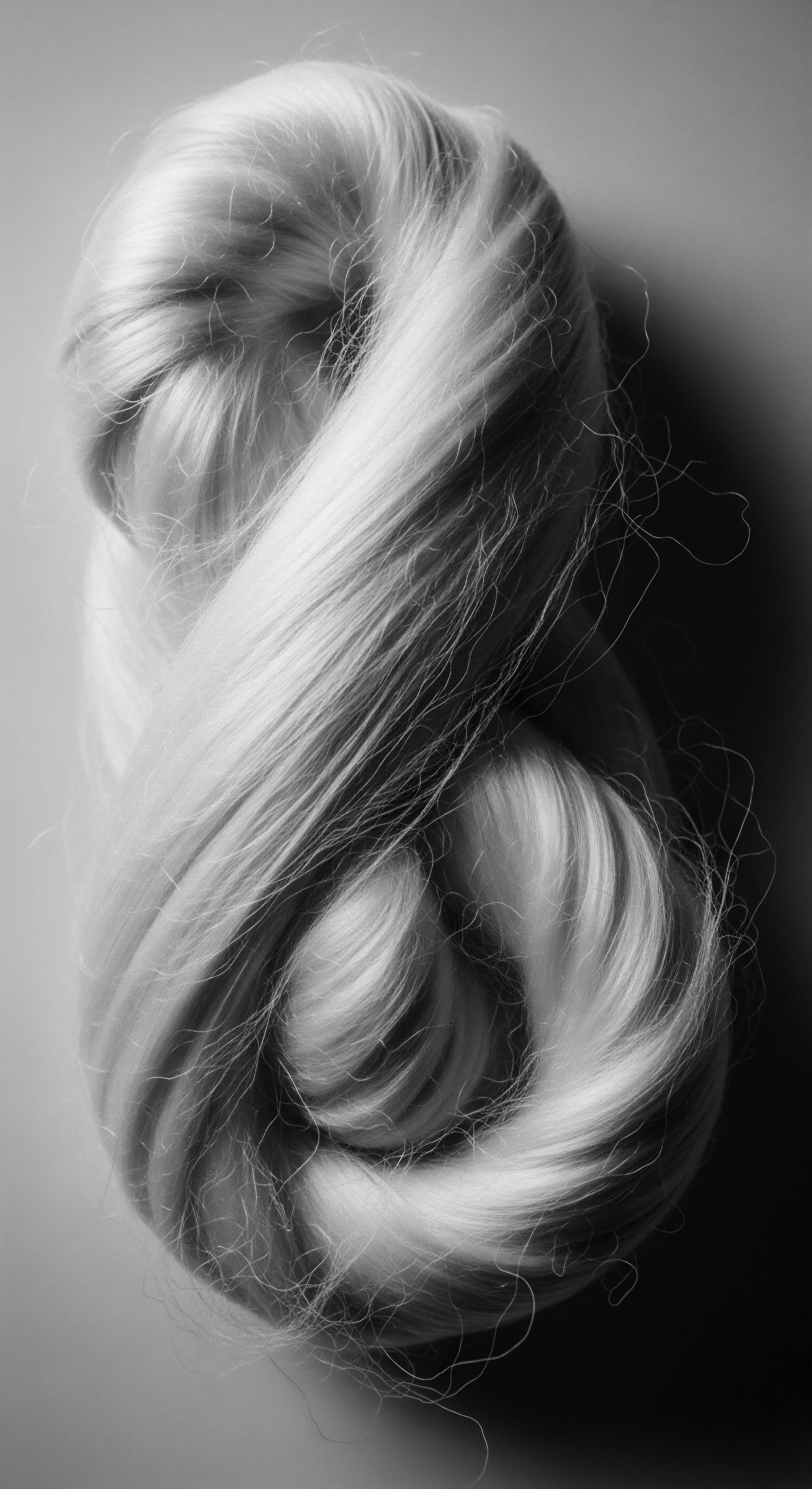
Reflection on the Heritage of UV Hair Damage
The journey through the intricate layers of UV Hair Damage, from its elemental biology to its profound impact on human hair, particularly textured hair, leads us to a deeper contemplation of heritage. The Soul of a Strand ethos guides us to recognize that hair is never merely a collection of fibers; it is a living archive, a repository of stories, struggles, and triumphs passed down through generations. When we consider UV Hair Damage, we are not simply discussing a scientific phenomenon; we are engaging with the environmental realities that have shaped ancestral hair practices, influencing the very ways communities have lived and expressed their identities.
The enduring significance of UV Hair Damage within the context of textured hair communities is a testament to the continuous dialogue between humanity and its environment. From the scorching sun of the African savannahs to the varied climates of the diaspora, the hair has always been a barometer of external forces. Ancestral wisdom, manifested in the art of headwrapping or the judicious application of natural butters, stands as a profound counter-narrative to the idea that modern science holds all answers.
Instead, it reveals a continuum of knowledge, where ancient remedies often find their scientific validation in contemporary laboratories. These traditions were not born of abstract scientific inquiry but from generations of lived experience, observation, and the communal transmission of effective care rituals.
Hair, a living chronicle, whispers tales of resilience against the sun’s ancient touch, woven into the very fabric of textured heritage.
The evolving understanding of UV Hair Damage compels us to look back, not with nostalgia, but with profound respect for the ingenuity and adaptability of those who came before. The hair, in its myriad textures and forms, has absorbed not only sunlight but also the cultural shifts, the imposed standards, and the reclaiming of selfhood that define its heritage. Each coil, each kink, each wave holds the memory of protective styling, of oils lovingly massaged, of communal grooming sessions that transcended mere aesthetics to become acts of connection and preservation.
This reflection underscores that care for textured hair, especially in the face of environmental challenges like UV radiation, is not just about chemical compounds or technological advancements; it is an act of honoring lineage, a celebration of resilience, and a conscious step towards nurturing the physical and spiritual well-being embedded within each strand. The unbound helix of textured hair continues its journey, carrying the echoes of its source, strengthened by the tender threads of tradition, and poised to shape a future where its inherent beauty and profound heritage are fully recognized and protected.
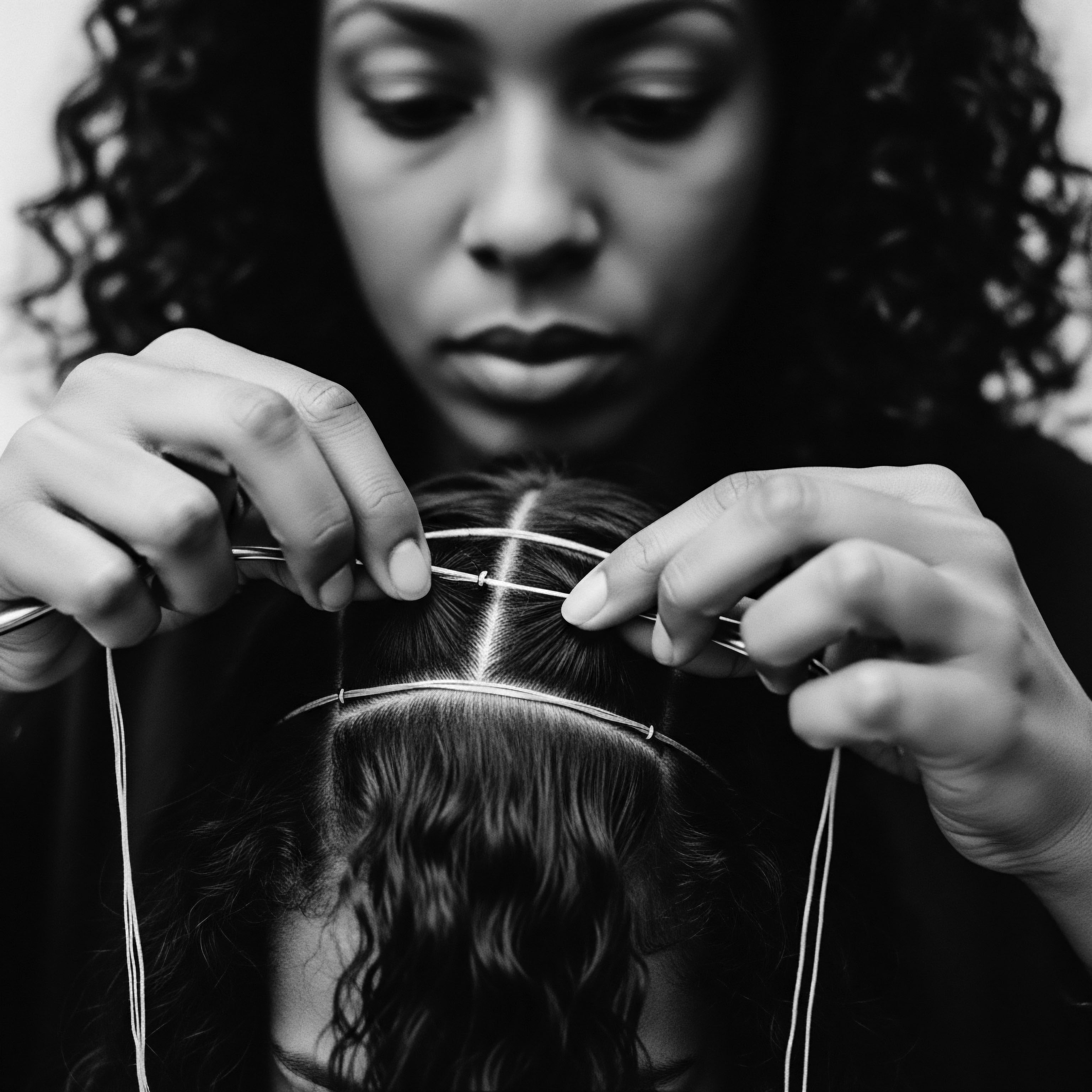
References
- Aghajanian, L. (2018). The Tignon Laws ❉ A History of Hair and Power in New Orleans. University of Louisiana Press.
- Almeida, J. (2012). The Science of Hair Care ❉ From Ancient Practices to Modern Formulations. Elsevier.
- Diop, T. (1996). Les Plantes Medicinales, Sénégal. Presses Universitaires de Dakar.
- Falconi, D. (1998). Earthly Bodies and Heavenly Hair. Ceres Press.
- Gamblin, S. (2019). African Hair ❉ The Legacy of Traditional Hair Care. Black Arts Publishing.
- Hampton, A. (1997). Natural Organic Hair and Skin Care. Organica Press.
- Longo, V. M. et al. (2013). International Journal of Cosmetic Science, 35 (6), 539-545.
- Nogueira, A. C. S. & Joekes, I. (2004). Hair color changes and protein damage caused by ultraviolet radiation. Photochemistry and Photobiology, 80(1), 108-115.
- Robins, R. (2000). The Cultural History of Hair. Routledge.
- Schneider, J. (2017). Hair and Identity ❉ A Cultural History. University of Chicago Press.
- Zhao, Z. et al. (2020). Journal of Agricultural and Food Chemistry, 68 (25), 6900–6909.
